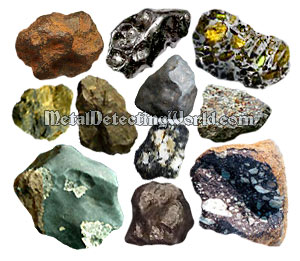Types of Metal Detecting Activities, page 35:
METEORITE HUNTING: General Information, Tips, Metal Detectors and Accessories Required

Detecting Meteorites, Meteorite Hunting or Meteorite Prospecting relates to searching for the extraterrestrial objects that reach the surface of the earth after falling through the earth's atmosphere. Most meteorites are fragments of asteroids and comets traveling through space.
The smaller group comprises pieces of planets and their natural satellites, which were launched into space by forceful collisions with large asteroids and comets.
These meteorites are highly sought by meteorite hunters not only for their rarity but also for their value: a 10g piece of Mars can bring you $10,000!
The value of meteorite also depends on its composition, and meteorites of certain classes are more valuable than diamonds. But the three basic types of meteorites are Stone, Iron and Stony Iron (for more details visit my "Classification of Meteorites" page).
If you are meteorite prospecting near glaciers or ice fields, keep in mind that single rocks are seldom found embedded in ice, and it could be a rare kind of meteorite. This is why developing your observation skills is important in meteorite hunting.
Some museums and universities have paid from $200 to $5,000 per gram for rare specimen.
Most iron meteorites are sold or traded by collectors from $0.10 to $1.50 per gram, depending upon their variety, authenticity and size. Like gold nuggets, the price is determined by the market.
In any case, meteorite hunting is an exciting metal detecting activity because meteorites are scarcer than gold, and finding them is quite challenging.
Where To Search For Meteorites
The best area for meteorite hunting is where the terrain is bare of trees and vegetation, and the climate has insufficient rainfall to support vegetation growth. Such conditions would provide the best preservation of meteorites and their recovery (see more details HERE).
Since the deserts, steppes, dry lake beds are the optimal areas for detecting meteorites, the US Southwest, Northwest Africa (Sahara desert), Australia are the prime meteorite hunting territories in the world. Of course, the meteorites continuously fall all over the Earth, but you will more likely to find them where there are bare grounds and arid climate.
The most unusual case of meteorite location exists in Northern Africa where the ancient caravan routes are marked by Cairns - improvised "road signs", that look like piles of stones. Only the stones are meteorites, and their average age is 30 million years!
When you are in the meteorite detecting area, you should look for a Strewn Field - a wide area over which meteorites have exploded, fragmented, and dispersed pieces. This zone can cover just a few square acres or several thousand square miles like in the Sahara desert. Also, craters that were created by large meteorite impacts would present an opportunity for meteorite detecting.
In any case, meteorite hunting areas may contain meteorite material ranging from small pieces barely distinguishable from surrounding rocks to large boulders standing out like a landmark. The meteorites may range in weight from 1 gram to 1 ton, and the levels of iron content in their composition may range from high to barely a trace.
Research
To determine the meteorite hunting area that is close to where you are or other productive areas, you need to do a little homework - meteorite database research on the internet. If you just type "meteorite database" keyword phrase into any search engine, you will be able to find all in-depth information - all registered and classified meteorite finds made in both the US and the world, GPS coordinates of their locations, and links for maps and satellite photos.
You can also obtain this and a wealth of other useful information from the websites of various Meteoritical Societies. One of such informative resources is the USGS Meteoritical Society's website: http://tin.er.usgs.gov/meteor/.
Getting Permission
After you obtain the meteorite location coordinates from the database, make sure that the area is not off-limits. Most likely the property may be private, State, or Federal land and you cannot hunt there without permission. Just like in any type of metal detecting activities, if the land is private, getting the land owner's written permission is your first step (see details in my article - How To Get Permission for Metal Detecting)!
If you are to hunt State or Federal land, contact local authorities and find out what is required for getting permission to metal detect in that area. If the fall site happened to be on Federal land, any finds must be reported and turned over to the Smithsonian Institution in Washington, D.C.
While searching for meteorites, always make sure you have a written or printed permission with you! To make sure you know where you are and that you do not venture onto someone else's property, bring along a detailed topographic map.